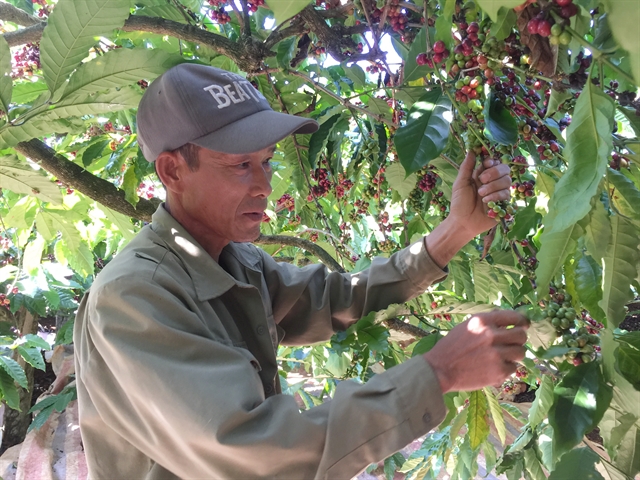 Economy
Economy


|
| A farmer in Lâm Đồng Province harvests his coffee crop. Vietnamese coffee exports are down and the trend looks set to continue. — VNS Photo Xuân Hương |
HCM CITY — Việt Nam’s coffee exports have fallen in both volume and value terms this year, according to the Ministry of Agriculture and Rural Development.
It exported 629,000 tonnes worth US$1.1 billion in the first four months, a year-on-year decrease of 13.4 per cent in volume and 22.5 per cent in value.
The trend is forecast to continue this month, the ministry said.
Nguyễn Quốc Toản, director of the ministry’s Agro Processing and Market Development Authority, said global prices fell further this month to around US$1,295 per tonne on average from $1,679 in April.
Abundant supply and low demand, as well as the effect of the escalation of the US-China trade war on many markets have pulled prices down.
In the domestic market, prices have fallen to below VNĐ30,000 ($1.29) per kilogramme last week, the lowest level in the last 10 years.
According to the Việt Nam Coffee and Cocoa Association, exporters have been facing fierce competition from other major exporting countries.
Exports to traditional markets such as the US and Germany dropped respectively by 19.8 per cent and 13 per cent in the first four months of the year, Nguyễn Viết Vinh, the association’s general secretary, said.
Vietnamese exports faced great competition from Brazil and Colombia in these two markets, he said.
Exports to other markets such as Japan, Algeria, South Koea, France and India had also fallen significantly, he said.
Minister of Agriculture and Rural Development Nguyễn Xuân Cường said Việt Nam is the world’s second largest coffee producer, but since its prices greatly depended on global prices the domestic industry was unstable.
Around 90 per cent of exports were raw coffee, making it difficult for local exporters to build brands for their products, he said.
In addition, the sector’s weakness in all areas from the production to trading was one of the main reasons the country was unable to influence global coffee prices, he said.
To overcome this, the coffee industry needed to change its production methods with increased use of technology to ensure quality, he added.
According to the association, with importing countries increasing technical barriers for coffee products, ensuring quality has become imperative.
In addition to planting new high-quality strains to replace old and stunted coffee, the main coffee growing localities should enhance the use of technology in all stages from planting and harvesting to drying, preserving and processing, it said.
Cường said: “New free trade agreements such as the EU-Việt Nam FTA and the Comprehensive and Progressive Agreement for Trans-Pacific Partnership (CPTPP) will open opportunities for Vietnamese firms to boost exports thanks to lower import tariffs, especially on processed coffee products.
“Therefore, Vietnamese enterprises need to seize this opportunity.”
He also urged them to focus on improving quality, diversifying and increasing exports of high-value processed products.
The coffee industry has carried out a restructuring programme to improve its competitiveness by improving productivity, quality and value.
Cường said the sector would not expand the area under coffee until 2030, but focus on improving value addition, productivity and linkages in the value chain.
The programme envisages having more than 80 per cent of raw coffee processed industrially and 30- 40 per cent processed intensively and branded by 2030. — VNS




